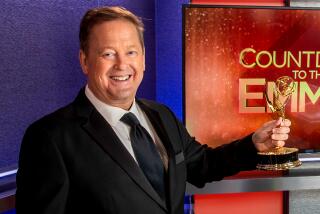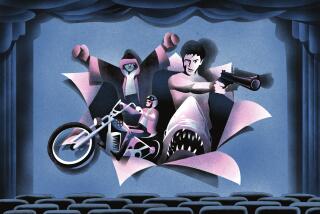Roger Ebert dies at 70; Pulitzer Prize-winning film critic
Roger Ebert, the Pulitzer Prize-winning movie critic whose gladiatorial âthumbs-up, thumbs-downâ assessments turned film reviewing into a television sport and whose passion for independent film helped introduce a new generation of filmmakers to moviegoers, has died. He was 70.
Ebert, who had battled cancer in recent years, died Thursday in Chicago, according to the Chicago Sun-Times, where he had been film critic for 46 years. He had undergone several surgeries to remove cancerous tumors from his thyroid and salivary glands, ultimately losing his jaw and speaking voice to the disease.
While his cancer diagnosis and the resulting treatments forced him briefly to pull back from criticism in 2006, he remained active as a writer and maintained a powerful presence on social media sites that included his award-winning blog, Roger Ebertâs Journal, where he candidly discussed his failing health. By his count, in 2012 he wrote more than 300 reviews, more than in any year of his career.
RELATED: Fans, celebs react to Ebertâs death
Earlier this week he announced on the blog that he would be taking âa leave of presenceâ and scaling back from writing.
âRoger through his reviews, blog posts and tweets brought the appreciation of film, and film criticism, to the widest possible audience and into the 21st century,â Times film critic Kenneth Turan said Thursday. âAnd his refusal to give an inch to a terrible disease was beyond inspirational.â
In May 2008, Ebert had returned to writing movie reviews for the Chicago Sun-Times but essentially said goodbye to the TV show that made him famous. Cancer had robbed him of his voice, and Ebert refused to face another surgery that could restore it.
PHOTOS: Roger Ebert - Career in Pictures
âI still have all my other abilities, including the love of viewing movies and writing about them,â Ebert wrote in 2008 in the Sun-Times.
As the longtime and prolific critic for the Chicago newspaper, he wrote reviews while co-hosting a popular nationally syndicated TV show that, in the 1980s, was known as âAt the Movies.â Ebert was the first movie critic to win journalismâs most prestigious award, collecting his Pulitzer in 1975, but he had the greatest impact through his TV forum, which began that same year on Chicago public television.
The TV reviews were not always the most sophisticated or reasoned, but they were widely influential. Ebert and his co-host â most famously, rival Chicago Tribune newspaper critic Gene Siskel, his broadcast partner for 23 years â would quarrel over a filmâs merits, then render judgment with a simple thumbs-up or thumbs-down score.
While the impact of any single film critic has declined in recent yearsâmoviegoers typically rely on aggregate scores and word-of-mouth adviceâthe power of that single digit was profound. Hollywood marketing chiefs considered a dual thumbs-up recommendation more important (and marketable) than any other reviewerâs praise, and prominently featured the marks in advertising. The thumbs even were registered as a trademark.
PHOTOS: Notable deaths of 2013
Approval from Ebert and his sidekick not only could influence mainstream box office fare but also deliver ticket buyers to more daring, artistic works that relied upon critical word-of-mouth. This was how Ebert, with other critics, successfully encouraged audiences to seek out independent films, which in recent decades have come to dominate the Academy Awards.
To encourage its theatrical prospects, Ebert glowingly reviewed the documentary âHoop Dreamsâ before the independent film even premiered at the 1994 Sundance Film Festival. He later named the high school basketball film the best cinema work of the 1990s. He and Siskel also pushed audiences to see such movies as diverse as 1986âs âTampopoâ and 1992âs âOne False Move.â
Ebert remained a champion of quality movies that had failed to attract wide attention. In 1999, he launched a film festival now known as Ebertfest, an annual celebration of usually independently financed films staged at his alma mater, the University of Illinois at Urbana-Champaign.
At the 2009 Ebertfest, Ebert and his wife, Chaz, announced that they had given the university a $1-million gift toward the creation of a film studies program.
When Siskel â who died at 53 from brain cancer in 1999 â and Ebert started their movie review show more than 35 years ago, cineastes could browse highbrow film journals and take in Francois Truffaut retrospectives at museums and universities.
Average moviegoers subsisted on occasional magazine profiles or brief wire service reviews in newspapers. Most coverage preceded a filmâs opening; opinions about its execution were harder to find, particularly on television.
âWhat Siskel and Ebert did was to pioneer the middle ground,â said Robert J. Thompson, director of the Center for the Study of Popular Television at Syracuse University. âThey had a significant impact on film criticism.â
RELATED: Fans, celebs react to Ebertâs death
Ebert also was one of the first journalists caught in the crossfire of media consolidation. When the Walt Disney Co. began distributing his show in 1986, analysts wondered if Ebertâs integrity would be compromised, since a movie company was writing his paycheck. Ebert insisted that while the Disney deal made him rich, his independence was untarnished.
Ebertâs criticism could be unsparing. He said of J.J. Abramsâ âMission: Impossible IIIâ (2006) that âmodern high-tech action sequences are just the same damn thing over and over again.â In a 2000 book, âI Hated, Hated, Hated This Movie,â Ebert rounded up some of his more scathing reviews of films whose âdegree of badnessâ ranged from âdeplorableâ to âmerely hilariously misguided,â he wrote.
The critic had his own detractors. Some film veterans believed that his âthumbs-up, thumbs-downâ rankings (really good movies earned two thumbs âway upâ) made criticism less thoughtful, even infantile. During the late 1980s, influential New Yorker magazine critic Pauline Kael ridiculed Siskel and Ebert as âthe Katzenjammer Kids,â the comic stripâs goofball twins.
In 2008, Ebert came under fire for writing a negative review of the independent film âTru Lovedâ after viewing only eight minutes of it, a fact he revealed at the reviewâs conclusion. Ebert apologized on his blog and posted a review of the film, which was still negative, after watching it in its entirety.
Roger Joseph Ebert was born June 18, 1942, in Urbana, Ill., the only child of Walter, a University of Illinois electrician, and Wanda, a bookkeeper. He often saw movies with an aunt.
PHOTOS: Roger Ebert - Career in Pictures
Shortly before his father died of cancer in 1960, Ebert won first place in an Illinois Associated Press sportswriting contest. The high school senior already worked for a local paper.
At the University of Illinois, Ebert edited the student newspaper and freelanced for Chicago newspapers. After receiving a bachelorâs degree in journalism, he dropped out of a University of Chicago doctoral program to take a Sun-Times feature-writing job.
Before he became a recognizable critic, Ebert wrote several 1970s B-movie screenplays, including âBeyond the Valley of the Dollsâ and âBeneath the Valley of the Ultra-Vixensâ; none attracted terribly strong notices.
His writing ease amazed and annoyed colleagues. While others agonized, he was known to stroll into the office half an hour before deadline, tell some jokes, then pound out his piece.
The idea for the TV show that would make him a multimillionaire was hatched by two Chicago public television producers. One, Thea Flaum, insisted on pairing Ebert with Siskel â the two were fierce archrivals â since Siskel wrote for the competing Chicago Tribune.
Ebert was âthe most hated guy in my life,â Siskel once said. Ebert later said, âI think each of us initially said yes because we didnât want the other guy to do it first.â Well after the show was a hit, they could refuse to share an elevator.
âOpening Soon at a Theater Near Youâ debuted in 1975. The format remained relatively constant: Two critics sit in movie seats, one offers a synopsis of a new film, clips are shown, and the critics debate the filmâs merits.
Even though their tastes were often similar, Siskel and Ebert made much of their differences â one was bald, the other overweight, Siskel the more intellectual, Ebert the more populist. They could bicker like an old married couple, which made the show endearing to many and unbearable to a few.
âSometimes, in the heat of argument, it sure feels like hate,â Siskel said in 1998 of his relationship with Ebert. âYou canât pay two guys all of their adult lives to have opinions and not expect them to have strong opinions about each other.â
By the end of the first season, the show was on more than 100 public television stations. In 1978, it was named âSneak Previewsâ and moved to PBS, reaching 180 markets, making it the highest-rated entertainment show in the history of public broadcasting, Television Week reported.
By 1982, the program was syndicated by Tribune Entertainment and called âAt the Movies.â Four years later, along with another name change, to âSiskel & Ebert at the Movies,â came yet another syndication distributor â Disneyâs Buena Vista Entertainment, and the idea to incorporate the opposable thumb into their on-air reviews, a concept that Ebert claimed as his own.
âThe Siskel-Ebert chemistry was perfect,â Thompson said. âThey were both curmudgeons, and neither one was attractive in conventional TV terms. The style of the show was one step up from cable access.... That was a good, shrewd choice for them, because so much in the film world had been slicked-up to within an inch of its life.â
At the University of Chicago, Ebert taught film studies for years, and he recorded DVD commentaries for favorite films, including âCitizen Kane.â
Ebertâs books included the predictable but popular collections of reviews, but also fiction (âBehind the Phantomâs Maskâ) and travelogues (âThe Perfect London Walkâ). In 1987, he published a memoir of the Cannes Film Festival, âTwo Weeks in the Midday Sunâ and in 2012, a personal memoir, âLife Itself.â
After Siskel died, Ebert auditioned 38 potential co-hosts. His last TV partner, Richard Roeper, had not sought the job; he is a Sun-Times pop culture columnist. When cancer left Ebert unable to speak, Disney covered for his absence with a series of fill-in hosts before settling on Michael Phillips of the Chicago Tribune.
In 2008, Ebert and Roeper cut ties with Disney and the show. They announced plans to put together a new review show featuring the pair but it did not materialize.
With professional help, Ebert had lost about 100 pounds but was frustrated that people linked his initial weight loss to his cancer. The once-robust, stout and avuncular critic had given way to a much frailer man who relished the voice he still had through the written word.
âIt is saving me,â he said in 2010 in Esquire.
Ebert often said what he admired most about Siskel was his obvious love for his wife and children. When Ebert married Chaz Hammelsmith, an attorney, in 1992, she was a divorced mother of two in her 40s. He was 50.
He was âso grateful to have a family,â Marsha Jordan, a Chicago television producer, said in 2005. âThis woman came along at a time when she brought exactly what he needed.â
Ebertâs wife survives him along with two stepchildren and four grandchildren.
At the conclusion of his final blog post this week, Ebert wrote, âOn this day of reflection I say again, thank you for going on this journey with me. Iâll see you at the movies.â
Times staff writer Scott Collins contributed to this report.
More to Read
Start your day right
Sign up for Essential California for the L.A. Times biggest news, features and recommendations in your inbox six days a week.
You may occasionally receive promotional content from the Los Angeles Times.








